In proving foresight may be vain;
The best-laid schemes o’ mice an’ men
Gang aft agley,
And lea’e us nought but grief an’ pain
For promised joy!
Robert Burns 1785
When Abu Zubaydah was captured in a fire fight in Pakistan on March 28, 2002, there was a lot of excitement in Washington. Our first "high value" detainee, Ibn al-Shaykh al-Libi, had been sent to Egypt and confessed that al Qa’iada had ties with Saddam Hussein, but our intelligence people didn’t believe him. They thought he was just trying to avoid being tortured. So, even though he was severely wounded, Abu Zubaydah was a second chance. On March 31, 2002 he was flown to Thailand and his interrogation by Ali Soufan, a multi-lingual FBI Agent trained in rapport building, began soon after his arrival.
In proving foresight may be vain;
The best-laid schemes o’ mice an’ men
But Washington had other ideas. President Bush had already declared that al Qa’iada and Taliban Detainees did not meet the criteria for the Geneva Conventions, bolstered legally by an Memo from the Office of Legal Counsel at the Department of Justice. And two psychologists, James Mitchell and Bruce Jessen, who had been involved in training our soldiers to resist torture [SERE] were proposing that their training techniques could be "reverse engineered" as interrogation techniques. Mitchell flew to Thailand and joined the FBI/CIA interrogation team. The interrogation sessions of Abu Zubaydah were taped from the start. This email was in the recent ACLU FOIA packet:
 |
Followed by this enjoinder to be sure to preserve an accurate visual record:
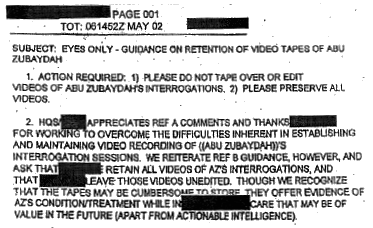 |
There were high level meetings in Washington about Abu Zubaydah, and by mid April, John Yoo of the OLC had started to work on the legalities of aggressive interrogation techniques. Clearly, they were already using these techniques on their prisoner. They had gotten preliminary permission to use 24-48 hours of sleep deprivation. "Due to a misunderstanding," they exceeded that limit. And since their prisoner didn’t hallucinate, they decided longer times were allowed [it became 11 days in the later Memo]. In mid-May 2002, Ali Soufan balked when he found them constructing a box for a "mock burial." Since he was unable to stop the use of these techniques, the FBI refused to participate further in this "borderline torture" and Soufan came home.
On July 13, 2002, they figured out that Zubaydah was already being aggressively interrogated and John Yoo sent a preliminary guideline, but his definitive Memo didn’t become official until August 1, 2002. In preparation for using these "Enhanced Interrogation Techniques" officially, they did a Psychological Evaluation of Zubaydah on July 24, 2002 that was included in Yoo’s Memo. By this time, President Bush had "unsigned" our agreement to participate in the International Criminal Court Treaty.
Gang aft agley,
And lea’e us nought but grief an’ pain
For promised joy!
Abu Zubaydah‘s "Enhanced" Interrogation began in earnest after the Memo became official. We know that he was waterboarded at least 83 times. I don’t think we have any real idea of how long it went on, or whether it produced what they call "actionable intelligence." What we do know it that there were a total of 92 videotapes recorded of his interrogation. By September 5, 2002, the C.I.A. had lost its enthusiasm for holding onto these tapes to "offer evidence of AZ’s condition/treatment":
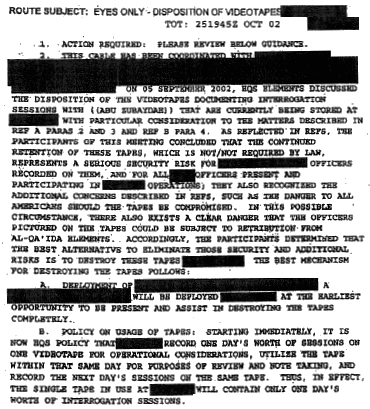 |
But by December 3, 2002, they’d changed their minds about destroying the tapes [here‘s emptywheel‘s comment about why]:
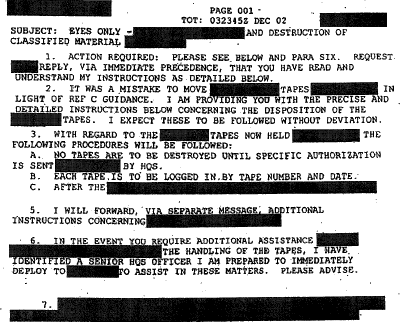 |
What was the "mistake?" Where did they "move" the tapes? There’s a lot of speculation about that [see comments here], but the consensus seems to be that they were moved somewhere and cataloged, thus becoming a part of some government record – that was the mistake because they officially existed. In any case, on January 9, 2003, CIA Attorney John McPherson reported on his December 2002 on-site review of the tapes – "Nothing out of the ordinary." That review was reviewed along with the tapes by the CIA Inspector General in June 2003 at which time tape erasures/deletions were noted. It’s unclear if they had been there when McPherson looked at them. Time passed, and on November 9, 2005, the tapes were destroyed by order of Jose A. Rodriguez, the head of the CIA’s clandestine service. I’ve left the sequence that lead up to that action out because it’s hard to really know how it came to happen and who was really involved. Here’s an overview of those cables from the recent release:
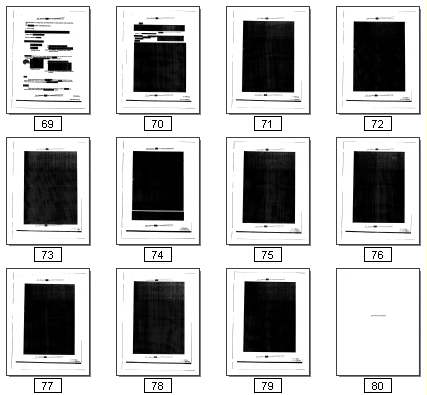 |
But here’s the punch line, the day after the tapes were destroyed, there were two emails to Dusty Foggo, then the Executive Director of the CIA under Director Porter Goss [Dusty Foggo is currently imprisoned in Pine Knot Kentucky, convicted of taking bribes on CIA contracts]:
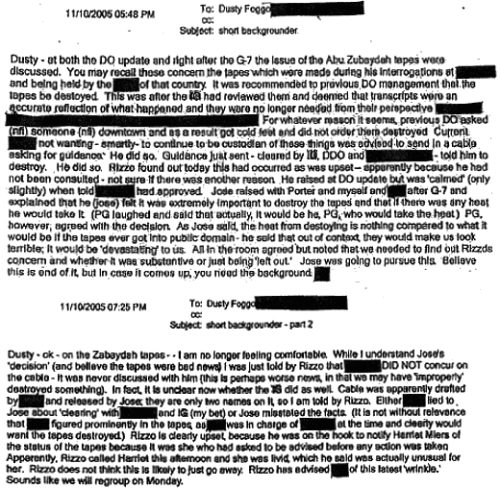 |
So it wasn’t even clear to them who authorized what. The New York Times had revealed the "extrordinary renditions" on March 6, 2005 and the Washington Post had broken the story about the CIA’s "black sites" on November 1, 2005 [probably instigating the push to destroy the tapes]. But it wasn’t until December 6, 2007 that the New York Times reported that the CIA had destroyed the tapes.
[…] is the CIA Agent who ordered the tapes of Abu Zubaydah being tortured to be erased [my timeline is here]. The New York Times had revealed the "extrordinary renditions" on March 6, 2005 and the […]
[…] is the CIA Agent who ordered the tapes of Abu Zubaydah being tortured to be erased [my timeline is here]. The New York Times had revealed the "extrordinary renditions" on March 6, 2005 and the […]